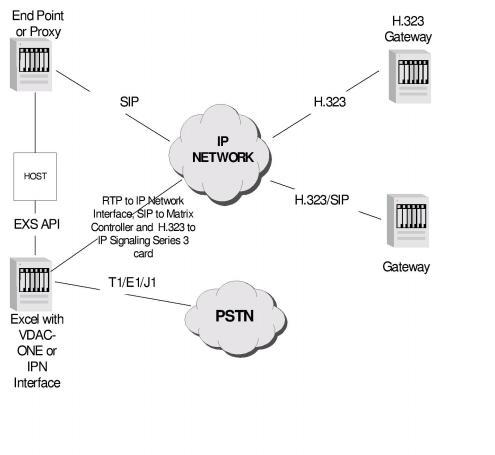
You are here: CSP Developer’s Guide: Internet Protocols > 2 VDAC-ONE Card > VDAC-ONE Card Overview

The VDAC-ONE (Voice-Data Access Concentrator) card performs two-way conversion between circuit-switched data and packet-switched Ethernet data. This conversion is required by packetized voice applications such as the Voice over Internet Protocol (VoIP). The card also integrates media resources over IP technology.
The VDAC-ONE card converts circuit-switched voice to IP packets, employing compression algorithms that can increase capacity toward the IP network side. You can have parameters modified for an individual call, often while the call is active, changing the quality of service, as needed.
Integrating media resources using IP technology provides many advantages. Typically, media resources are connected by T1, E1, or J1 interfaces that consume one 64 Kbps port per call, limiting the capacity of the system. The VDAC-ONE card integrates media resources over IP using the standards-based Real-Time Protocol (RTP).
Integrating media resources using standards-based technology also allows media resources to be shared between the CSP and other network infrastructure. Packet switching to media resources allows the application to benefit from voice compression, increasing capacity on the application. This flexibility allows the CSP and the applications to scale independently and incrementally, as needed, eliminating excess hardware.
Each VDAC-ONE card consists of 160 channels divided into five spans each with 32 channels. Each VDAC-ONE card has a main board and four modules 0-3.
Use the IP Address Configure message to assign the main board and each module an IP address, subnet mask, and gateway IP address. Assign up to five logical spans on the VDAC-ONE card using the Assign Logical Span ID message. Use the Resource Attribute Configure message to assign attributes to the VDAC channels or modules.
Important! Span/Channel is bound to an IP Address/Port during call setup. The Route Control/Outseize Control messages are used to initiate the call and bind a Span/Channel to the IP Address/Port. This association lasts for the duration of the call.
The VDAC-ONE card has its own resources to provide echo cancellation, silence suppression, and detection of fax tones. Multiple VDAC-ONE cards can populate one node and interoperate with all other CSP cards.
Important! The CSP supports eight VDAC-ONE cards per chassis.
Adding the VDAC-ONE card to existing enhanced-service platforms allows applications to be quickly IP-enabled, providing a significant advantage over other systems that require developers to rewrite the application for packet transport. The ability to support both circuit- and packet-based transport enables developers to create entirely new services, such as text-to-speech and web-based applications.
You can provide reliability for IP switching two ways with the
VDAC-ONE card.
• Each VDAC-ONE card has two 100 Base-T Ethernet ports that you can connect to separate Ethernet switches, providing link-level redundancy.
• Using multiple VDAC-ONE cards provides card-level redundancy with load sharing, where sufficient VDAC resources exist to keep the system operational when one card goes out of service. The host must first transfer those resources to the other cards with the Assign Logical Span (0x00A8) message. (Note that existing calls on the failed VDAC-ONE card will drop and subsequent calls are directed to available resources on another card.)
Cost Effective Service Integration
Adding packet switching capabilities to the already flexible CSP provides many additional cost-saving and revenue-generating benefits. The ability to compress voice increases system capacity toward the IP network side, allowing the same amount of bandwidth to transport voice more cost-effectively, and allowing the excess bandwidth to support more customers. Using packet transport for media resources extends the capacity gains of voice channels to the resource, allowing each service to handle greater call volumes.
Integrating applications through IP provides scalability for the applications because they are no longer limited by the number of interface ports available. The standards-based transport technology allows you to easily add third-party applications. This integration method allows multiple, multi-vendor applications to operate on a single system. Other networks can also share these resources because RTP is a standards-based integration technology.
Figure 2-1 Protocol Interworking through the VDAC-ONE card
